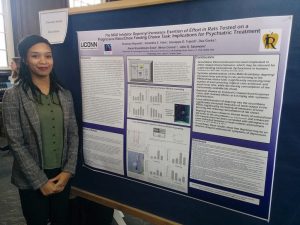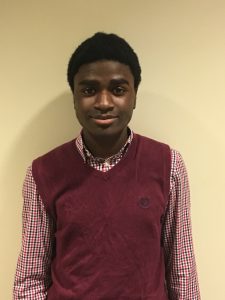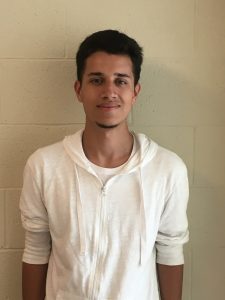UConn Year of Graduation (Undergraduate): 2016
Undergraduate Major(s): Allied Health Sciences
Currently Employed By: Hartford Hospital, PCA
Updates: Currently in the Masters in Public Health program at UConn Health hoping to graduate in the spring of 2018.
Author: Hoffmann, Jessamy
Rowe Alumni Spotlight: Molly Honda
UConn Year of Graduation (Undergraduate): 2014
Undergraduate Major(s): Dietetics
Currently Employed By:
Updates: After working at Albany Medical Center as a Clinical Dietitian for the past two years, I recently started PA school at Albany Medical College this January. I am very excited for this change of pace and to broaden my knowledge of medicine, and should be graduating in May 2019.
Rowe Researcher: Understanding the Role of SR-B1
Understanding the Role of SR-B1 in Lipid Metabolism and Inflammation
Summer 2016
Investigators: Christopher Blesso, Christina Jiang
SR-B1 is an HDL receptor that has a role in cholesterol exchange and the initiation of intracellular signaling cascades involved in lipid metabolism. SR-B1 is highly expressed in the liver, but its function has not been fully determined in adipocytes, which is the aim of this project. Cholesterol imbalance can result in disease states such as atherosclerosis, so the study of this HDL receptor can be implicated in disease prevention.
The aim of the research was to perform successful knockdown in 3T3-L1 adipocytes by using siRNA (scramble, cyclophilin, SR-B1); determine gene expression of SR-B1 and cyclophilin to confirm knockdown; determine inflammatory response of adipose by introducing LPS or macrophage-conditioned media to cells. After treating the cells with the appropriate reagents, RNA was isolated, cDNA was synthesized, and PCR was conducted to confirm knockdown. There was a 40% knockdown in cyclophilin when treated with cyclophilin siRNA and insignificant knockdown with SR-B1 knockdown. There is about a 60-70% knockdown of SR-B1 in adipocytes treated with SR-B1 siRNA, indicating that the knockdown was successful. In the presence of macrophages, there is about a 40% knockdown of SR-B1. In the presence of LPS, there is also about a 40% knockdown of SR-B1. These successful gene knockdowns provide evidence to continue on with the experiment.
Rowe Researcher: Drug Treatment for Depression

Drug Treatment for Depression: Deprenyl’s Effect on Motivation, Effort and Behavior
2015-2016
Investigator: Shanicka Reynolds
Depression is more than a feeling of sadness. It can progress into a disabling disease that degrades mental, physical, and social health. One of the most debilitating symptoms of depression is a decrease in motivational behavior. Motivational symptoms such as fatigue and anergia are difficult to treat and many of the existing antidepressants do not effectively treat motivational symptoms. This project will focus on the MAO-B inhibitor drug, deprenyl. The goal is to provide a more detailed characterization of the motivational effects of deprenyl through experimentation. Successful increase of motivational behavior using deprenyl will not only benefit patients suffering from depression, but will help patients of various disorders such as Parkinson’s where depression can be a side effect of their disease.
Rowe Researcher: Hydration in Collegiate Male Soccer Athletes
Knowledge and Assessment of Hydration in Heat Acclimatized Collegiate Male Soccer Athletes
Summer 2015
Investigators: Abigail Colburn1, Robert A. Huggins1, Andrea Fortunati1, David Looney1, Chris West1, Lawrence E. Armstrong, FACSM1, and Douglas J. Casa, FACSM1
1University of Connecticut
Fluid consumption during exercise can be influenced by vessel type and hydration knowledge, however athletes often are not given a choice of vessel and furthermore they are unaware of their individual fluid needs. PURPOSE: The aim of this single-blind matched pairs laboratory study was to investigate if hydration vessel has an impact on water consumption volume and if athletes are aware of their total body fluid balance. METHODS: Nineteen Division I male soccer athletes (age, 20±1 y; height, 180±7 cm; body mass, 78.68±7.39 kg) performed a standard 60 minute sweat electrolyte test in the heat and completed a hydration knowledge and strategy questionnaire afterwards. Ten participants consumed unlimited water from 1L commercial sports drink bottles typically used in practice (BTL), while 9 participants consumed unlimited water from a commercial water bladder hidden above them in the ceiling, only with access to the straw (BLA). Testing was conducted in a controlled environmental chamber, ambient temperature was 29.68±5.08°C, relative humidity 49.32±10.65%, and WBGT 19.32±4.43°C. Primary variables of interest included actual fluid consumed, perceived fluid consumed, actual sweat rate, and perceived sweat rate. Between group differences were analyzed using paired samples t-tests (a= p<0.05). RESULTS: There were no differences between BTL and BLA for amount of actual fluid consumed (BTL, 414.44±397.18mL; BLA, 390±288.21mL; p=0.879) actual fluid lost (BTL, 1415.56±368.62; BLA, 1344±452.14mL; p=0.712), perceived fluid consumed (BTL, 833±673mL; BLA, 565±461.64; p=0.321) or perceived fluid lost (BTL, 2444±1333; BLA, 2063±1778; p=0.607). However, when groups were combined, significant differences were found between the following variables. Perceived consumption was 692±572mL and actual consumption was 401.58±334.37mL (p=0.016). Perceived sweat losses were 2244±1552mL and actual sweat losses were 1377.89±404.90mL (p=0.015). Athletes only consumed 22.5±16.9% of actual fluid losses. Actual consumed and actual sweat losses were also significantly correlated (p<0.001). CONCLUSION: Although there were no differences between the type of vessel in which fluid was administered, NCAA Division I soccer athletes significantly overestimated both the amount of fluid they consumed and actual sweat losses during 60 minutes of exercise in the heat. These findings suggest that athletes are unaware of their individualized fluid needs, which may lead to involuntary dehydration.
Rowe Researcher: Lab-on-a-chip Device
Lab-on-a-chip Device for an Early Diagnosis of Cardiac Diseases
Spring 2016-Ongoing
Investigators: Elena Carrington, Karim Abdel Jalil, Dr. Chandra Kumar Dixit in the Chemistry as well as the Molecular and Cell Biology Department
Through various experiments, we are showing that microfluidic arrays can be used for detection of cardiovascular disease. We are examining troponin, C-Reactive Protein (CRP), and myoglobin as biomarkers for detection of cardiovascular disease. These biomarkers are used in a 3D printed microfluidic device, which is designed with an open source designing software, Autodesk 123. The fabricated chip has two distinct regions, viz fluidics and detection zone. Reagent delivery system is constituted of five micro-channels for transporting sample and reagents to the detection chamber. Monoclonal capture antibodies are spotted separately within the detection chamber. The sample and reagents follow to the waste chamber. The detection zone is spotted with monoclonal antibodies specific to the three biomarkers. The objective of our experimental design is to develop a microfluidic-based tool for multiplexed and highly sensitive detection of cardiovascular diseases. The experiments are ongoing; therefore, we do not have conclusive results at this time.
2016 Rowe Scholar: Michael Kerr

Michael Kerr is from Bloomfield, CT where he graduated from Bloomfield High School. As a high school student he attended the Mini Medical/Dental School program via UConn Health’s Health Career Opportunity Programs, and he played rugby for the West Hartford Black Hearts. Michael will be a Biological Sciences major at UConn.
Rowe Alumni Spotlight: Abigail Colburn
UConn Year of Graduation (Undergraduate): 2016
Undergraduate Major(s): Allied Health Sciences
Currently Employed By: UConn Kinesiology, Graduate Assistant/Student
Updates: I will be starting grad school this fall – a 2 year program in Exercise Science. I have a graduate assistantship in the EC Lee Lab and I will also be working as a medical scribe for Dr. Anderson in Student Health Services. I am also working on getting my undergraduate honors thesis published/presented this fall.
2016 Rowe Scholar: Kevin Okifo

Kevin Okifo moved to Naugatuck, CT from Bronx, NY just before starting fourth grade. Now a graduate of Naugatuck High School, he is a budding musician and a Biological Sciences major at UConn. Kevin has benefitted from the fact that his parents are both nurses as he has seen them working and caring for their patients. He has also shadowed an oncologist at Waterbury Hospital.
2016 Rowe Scholar: Brian Sullivan

Brian Sullivan is a Pre-Pharmacy major from East Hartford, CT. A graduate of Two Rivers Magnet High School in Hartford, CT, he has played the tenor saxophone for eight years. Brian is interested in diseases in the brain and has shadowed his cousin, a nurse at UConn Health, to learn about different roles in the medical field.